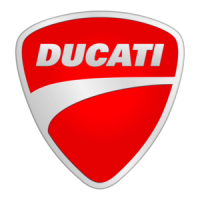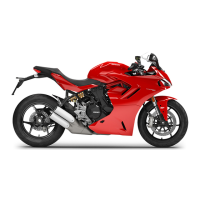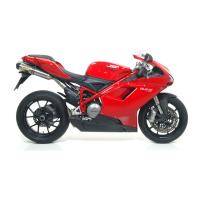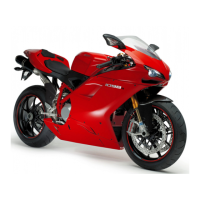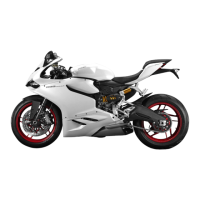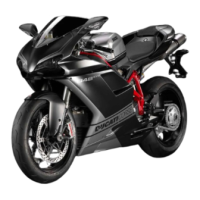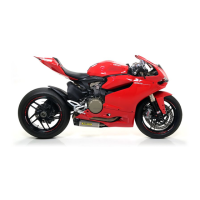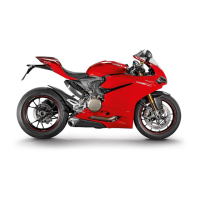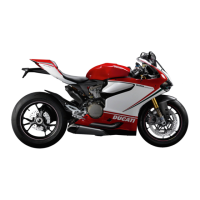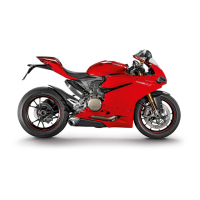Do you have a question about the Ducati SUPERSPORT and is the answer not in the manual?
Essential safety advice, rider responsibilities, protective gear, and operating precautions.
Locates and explains the importance of the engine identification number.
Details the function and meaning of specific indicator lights like Neutral, ABS, DTC, and DRL.
Explains how to use function buttons and navigate through instrument panel menus (Menu 1 & 2).
Guides on customizing riding modes, engine, DTC, ABS, DQS, and other system parameters.
Covers activating, changing, and using the PIN code for motorcycle security and operation.
Details Bluetooth setup, pairing, smartphone integration, and multimedia system functions.
Explains instrument panel service indicators and various system warnings.
Describes the different power modes (LOW, MED, HIGH) affecting engine response and delivery.
Explains the electronic throttle control system and its function.
Displays the total distance covered by the motorcycle in the selected unit of measurement.
Tracks partial distance, used for fuel consumption and speed calculations.
Tracks a second partial distance, useful for separate trip logging.
Indicates the estimated distance the motorcycle can travel with the remaining fuel.
Calculates and displays the duration of a trip since the last reset.
Allows setting and displaying the current time on the instrument panel.
Enables and displays lap timing data when activated from the settings menu.
Displays average fuel consumption calculated from fuel used and distance since TRIP1 reset.
Shows the engine coolant temperature in Celsius or Fahrenheit.
Displays real-time fuel consumption based on current engine and speed data.
Calculates and displays the average speed based on distance and time since TRIP1 reset.
Displays the temperature of the surrounding air in Celsius or Fahrenheit.
Allows enabling and adjusting the heated handgrips if installed on the motorcycle.
Guides on pairing, managing, and deleting Bluetooth devices like smartphones and navigators.
Indicates the first scheduled oil service reminder at 1000 km.
Shows remaining mileage or days until next Desmo, Oil, or Annual service.
Warns the rider when the vehicle's battery voltage is critically low.
Guides on personalizing engine, DTC, ABS, and DQS settings for each riding mode.
Covers activating, changing, and using the PIN code for motorcycle security and operation.
Allows adjustment of the instrument panel's display backlighting intensity.
Enables selection between automatic and manual modes for the Daytime Running Lights.
Allows setting and adjusting the current time displayed on the instrument panel.
Guides the user through setting the year, month, and day for the calendar.
Provides details on upcoming service intervals for Desmo, Oil, and Annual services.
Covers enabling, disabling, displaying, and erasing lap timing data.
Allows changing units for speed, temperature, and fuel consumption displays.
Allows checking the motorcycle's current battery voltage status.
Displays the engine's revolutions per minute (RPM) in digital format for accuracy.
Guides on recalibrating the system after tyre changes or sprocket ratio adjustments.
Covers activating the Bluetooth function and managing paired devices.
Explains how to switch between low and high beams when the Daytime Running Light is not active.
Details headlight operation and DRL switching with automatic and manual modes.
Procedure for obtaining and programming replacement keys with a Ducati dealer.
Enables temporary motorcycle operation using a PIN code in case of key malfunction.
Explains the function of handlebar switches, levers, throttle, and pedals for riding and gear changes.
Details the operation and adjustment of the gear change pedal and rear brake pedal.
Covers tank filler plug, seat lock, helmet cable, and side stand operation.
Guides on adjusting front fork and rear shock absorber settings for optimal handling.
Outlines the procedure for breaking in the new motorcycle for optimal performance and longevity.
Lists essential checks before riding and the correct procedure for starting the engine safely.
Explains how to start moving, shift gears, and brake effectively and safely.
Details the procedure for safely stopping the motorcycle and turning off the engine.
Provides instructions on safe refuelling practices, including fuel type recommendations.
Outlines proper procedures for parking the motorcycle, including security and ventilation.
Guides on removing and refitting fairings for maintenance access, emphasizing safety.
Details procedures for changing the air filter and checking/topping up coolant levels.
Explains how to check brake fluid level and inspect brake pads for wear.
Explains how to charge and maintain the battery, including winter storage procedures.
Covers checking drive chain tension and lubricating the chain for optimal performance.
Details how to replace headlight and turn indicator bulbs.
Guides on aligning headlights and manually adjusting rear-view mirrors for optimal visibility.
Provides information on tyre pressure, wear, and replacement procedures.
Guides on checking engine oil level and procedures for spark plug maintenance.
Provides guidelines for cleaning the motorcycle and storing it for long periods.
Lists operations to be performed by a dealer at specified mileage or time intervals.
Lists essential maintenance operations for the customer to perform at regular intervals.
Lists the motorcycle's weight specifications and overall physical dimensions.
Details engine type, displacement, power, torque, and recommended fuel specifications.
Covers specifications for the braking system and the motorcycle's transmission.
Lists specifications for the frame, wheels, tyres, and suspension systems.
Describes the exhaust system layout and the available colour options.
Identifies fuse locations, ratings, and how to access them for replacement.
Essential safety advice, rider responsibilities, protective gear, and operating precautions.
Locates and explains the importance of the engine identification number.
Details the function and meaning of specific indicator lights like Neutral, ABS, DTC, and DRL.
Explains how to use function buttons and navigate through instrument panel menus (Menu 1 & 2).
Guides on customizing riding modes, engine, DTC, ABS, DQS, and other system parameters.
Covers activating, changing, and using the PIN code for motorcycle security and operation.
Details Bluetooth setup, pairing, smartphone integration, and multimedia system functions.
Explains instrument panel service indicators and various system warnings.
Describes the different power modes (LOW, MED, HIGH) affecting engine response and delivery.
Explains the electronic throttle control system and its function.
Displays the total distance covered by the motorcycle in the selected unit of measurement.
Tracks partial distance, used for fuel consumption and speed calculations.
Tracks a second partial distance, useful for separate trip logging.
Indicates the estimated distance the motorcycle can travel with the remaining fuel.
Calculates and displays the duration of a trip since the last reset.
Allows setting and displaying the current time on the instrument panel.
Enables and displays lap timing data when activated from the settings menu.
Displays average fuel consumption calculated from fuel used and distance since TRIP1 reset.
Shows the engine coolant temperature in Celsius or Fahrenheit.
Displays real-time fuel consumption based on current engine and speed data.
Calculates and displays the average speed based on distance and time since TRIP1 reset.
Displays the temperature of the surrounding air in Celsius or Fahrenheit.
Allows enabling and adjusting the heated handgrips if installed on the motorcycle.
Guides on pairing, managing, and deleting Bluetooth devices like smartphones and navigators.
Indicates the first scheduled oil service reminder at 1000 km.
Shows remaining mileage or days until next Desmo, Oil, or Annual service.
Warns the rider when the vehicle's battery voltage is critically low.
Guides on personalizing engine, DTC, ABS, and DQS settings for each riding mode.
Covers activating, changing, and using the PIN code for motorcycle security and operation.
Allows adjustment of the instrument panel's display backlighting intensity.
Enables selection between automatic and manual modes for the Daytime Running Lights.
Allows setting and adjusting the current time displayed on the instrument panel.
Guides the user through setting the year, month, and day for the calendar.
Provides details on upcoming service intervals for Desmo, Oil, and Annual services.
Covers enabling, disabling, displaying, and erasing lap timing data.
Allows changing units for speed, temperature, and fuel consumption displays.
Allows checking the motorcycle's current battery voltage status.
Displays the engine's revolutions per minute (RPM) in digital format for accuracy.
Guides on recalibrating the system after tyre changes or sprocket ratio adjustments.
Covers activating the Bluetooth function and managing paired devices.
Explains how to switch between low and high beams when the Daytime Running Light is not active.
Details headlight operation and DRL switching with automatic and manual modes.
Procedure for obtaining and programming replacement keys with a Ducati dealer.
Enables temporary motorcycle operation using a PIN code in case of key malfunction.
Explains the function of handlebar switches, levers, throttle, and pedals for riding and gear changes.
Details the operation and adjustment of the gear change pedal and rear brake pedal.
Covers tank filler plug, seat lock, helmet cable, and side stand operation.
Guides on adjusting front fork and rear shock absorber settings for optimal handling.
Outlines the procedure for breaking in the new motorcycle for optimal performance and longevity.
Lists essential checks before riding and the correct procedure for starting the engine safely.
Explains how to start moving, shift gears, and brake effectively and safely.
Details the procedure for safely stopping the motorcycle and turning off the engine.
Provides instructions on safe refuelling practices, including fuel type recommendations.
Outlines proper procedures for parking the motorcycle, including security and ventilation.
Guides on removing and refitting fairings for maintenance access, emphasizing safety.
Details procedures for changing the air filter and checking/topping up coolant levels.
Explains how to check brake fluid level and inspect brake pads for wear.
Explains how to charge and maintain the battery, including winter storage procedures.
Covers checking drive chain tension and lubricating the chain for optimal performance.
Details how to replace headlight and turn indicator bulbs.
Guides on aligning headlights and manually adjusting rear-view mirrors for optimal visibility.
Provides information on tyre pressure, wear, and replacement procedures.
Guides on checking engine oil level and procedures for spark plug maintenance.
Provides guidelines for cleaning the motorcycle and storing it for long periods.
Lists operations to be performed by a dealer at specified mileage or time intervals.
Lists essential maintenance operations for the customer to perform at regular intervals.
Lists the motorcycle's weight specifications and overall physical dimensions.
Details engine type, displacement, power, torque, and recommended fuel specifications.
Covers specifications for the braking system and the motorcycle's transmission.
Lists specifications for the frame, wheels, tyres, and suspension systems.
Describes the exhaust system layout and the available colour options.
Identifies fuse locations, ratings, and how to access them for replacement.
| Displacement | 937 cc |
|---|---|
| Transmission | 6-speed |
| Frame | Tubular steel Trellis frame |
| Seat Height | 810 mm (31.9 in) |
| Engine Type | L-twin, 4 valves per cylinder, Desmodromic, liquid cooled |
| Max Power | 110 hp @ 9, 000 rpm |
| Max Torque | 93 Nm (68.7 lb-ft) @ 6, 500 rpm |
| Front Suspension | 43 mm upside-down fork |
| Rear Suspension | Sachs monoshock, adjustable for preload and rebound damping |
| Front Brake | 2 x 320 mm semi-floating discs, radially mounted Brembo Monobloc 4-piston calipers |
| Rear Brake | 245 mm disc, 2-piston caliper |
| Dry Weight | 184 kg (405.7 lb) |
| Fuel Tank Capacity | 16 l (4.2 US gal) |
